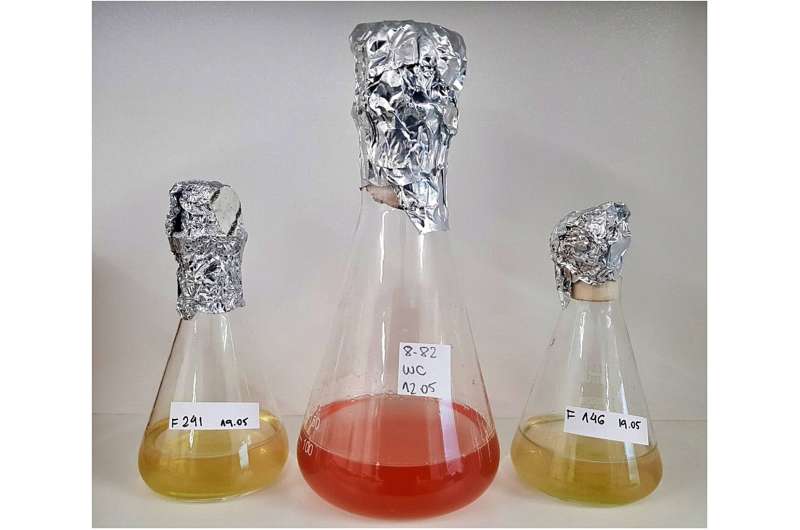Scientists from the Biology Centre of the Czech Academy of Sciences found forty new freshwater viruses infecting aquatic microorganisms this year. The first one, which they isolated and described in detail, was named Budvirus after the South Bohemian capital České Budějovice. It belongs to “Giant Viruses” and it infects unicellular algae called cryptophytes.
Researchers have confirmed that this virus has an important role in the ecosystem, as it controls algal bloom, helping to maintain balance in the aquatic environment. The discoveries of all the viruses were made at the Římov reservoir near České Budějovice, which has been regularly monitored by South Bohemian hydrobiologists for five decades and is one of the most studied freshwater reservoirs in Europe. The work is published in The ISME Journal.
Although we have freshwater ecosystems such as lakes, ponds, reservoirs and rivers all around us, their microscopic representatives, especially viruses and bacteria, are still a little-explored area. A drop of water can contain a million bacteria and ten times more viruses, but only a handful of them have been described. Recent methods, such as environmental DNA analysis, are making great strides in the study of the aquatic microworld. This is also one of the methods used by the Czech scientific team.
“The way it works is that we extract all the genetic material from a water sample, analyze it using DNA sequencing methods, and from this, we can trace which species of organisms were present in the water. This provides us with clues to find new viruses or bacteria,” explains Rohit Ghai, head of the Microbial Ecology and Evolution Laboratory at the Biology Centre CAS. Using these molecular clues, the scientists then search for the existing virus in other water samples. They also try to bring it to the laboratory, preserve it in laboratory conditions and subject it to detailed examination.

Flasks of Rhodomonas culture. The big red one in the middle is a healthy culture (not infected by virus); the green/yellowish ones on the sides are Rhodomonas cultures infected with giant viruses. © Helena Henriques Vieira, Biology Centre CAS
The newly discovered Budvirus likely inhabits many lakes in Europe or other continents
Hydrobiologists first detected the Budvirus this spring, at a time when microscopic algae grow rapidly in the water. They knew that thanks to planktonic predators (such as protozoa, rotifers or cladocera) and nutrient depletion, these algae would disappear again in a short time. But they have now confirmed that a newly discovered giant virus is a major contributor to this algal decline and that its activity is especially important during spring plankton growth.
“Budvirus is the first virus ever described that infects cryptophytes of the genus Rhodomonas, which are some of the most common phytoplankton algae. It can be assumed to be representative of a globally distributed group of viruses in freshwater ecosystems and to occur worldwide,” says team member Helena Henriques Vieira.
Budvirus capsid has an icosahedral shape measuring 200 nanometers, roughly ten times larger than the usual size of viruses. Its genome encodes over 400 proteins, half of them with an unknown function. There are many algae viruses of similar size called “Giant Viruses,” and Budvirus belongs to them.
Using environmental DNA, the researchers discovered that genetically almost identical giant viruses could be found in many lakes in Europe or other continents. In this respect, studying one location intensively has a worldwide impact on the study of microbes in freshwaters.

Sampling at the Rimov reservoir. © Petr Znachor, Biology Centre CAS

Římov reservoir near České Budějovice has been regularly monitored by Czech hydrobiologists for five decades and is one of the most studied freshwater reservoirs in Europe. © Petr Znachor, Biology Centre CAS
Discover the latest in science, tech, and space with over 100,000 subscribers who rely on Phys.org for daily insights.
Sign up for our free newsletter and get updates on breakthroughs,
innovations, and research that matter—daily or weekly.
Exploring the ecosystem players and their interactions helps to understand unexpected changes
Freshwater ecosystems are very dynamic environments, full of complex interactions between organisms—from microscopic bacteria, viruses, algae, and protozoa to larger organisms such as fish. Their mutual interactions, whether predation, parasitism, competition or symbiosis, have a major impact on the balance of the ecosystem and its ability to respond to external changes such as temperature fluctuations, changes in water chemistry or the introduction of new species.
With the new discovery, the team of Czech scientists is contributing to the understanding of the ecological and evolutionary interactions between viruses and their hosts in freshwater environments.
“It is important to have a thorough understanding of these ecosystem players and their interactions. When unforeseen changes occur in the water, we will know what happened,” adds Ghai.
More information:
Helena H Vieira et al, Isolation of a widespread giant virus implicated in cryptophyte bloom collapse, The ISME Journal (2024). DOI: 10.1093/ismejo/wrae029
Provided by
Biology Centre of the Czech Academy of Sciences
Citation:
Scientists discover a new giant virus that infects freshwater algae (2024, November 20)



